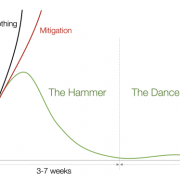Are Geographic Sales Territories Dying?
As the COVID impact increases remote working, virtual conference calls, and online purchasing, sales leaders need to be asking a simple question:
Should we actually eliminate geographic territories?
The simple answer is “No, but…..”. We all must recognize that for >100 years the entire DNA of the sales profession has been based on geography. Whether business-to-business selling, wholesale distribution, or retail outlets, being “close to your customers” meant building 1:1 relationships, solving customer problems locally, physically delivering products, and providing training and support services. No matter how “virtual” buyers become, shredding an entire sales infrastructure is both difficult and a threat to retaining revenue streams.
But the painful fact is that many customers are bypassing local sales channels in favor of online and virtual channels. Progressive sales leaders recognize a few inevitable trends:
- Face-to-face meetings are harder to schedule
- Customers are self-educating online without local sales support
- Customers expect greater sales expertise and experience in their specific industry or profession; reps can’t be experts in every industry
- Local sales reps also can’t keep up with the product knowledge depth needed to support broad, complex product lines
Many sales leaders argue – rightly – that these issues can be overcome and managed by what the profession calls “overlay” sales teams – subject matter experts (SMEs) for specific industries and products. These SMEs are typically remote, tele-based resources that customers and local sales resources can access for specific issues. Every company now has teams of “industry specialists” and “product specialists.” If these resources are not available or too expensive, the preferred alternative is large libraries of digital content with industry case studies and product specs that buyers can access. All good, right?
Not so fast. Many innovative sales leaders – typically from start-ups or companies that have gone through major restructuring – are asking a different question:
Why assign leads by a customer’s zip code when they could be routed to the “best available sales resource”?
Traditional sales teams place the “local rep” as the hub and coordinator of all sales opportunities and therefore planning. This can work well in many cases. But increasingly innovative sales leaders are “routing leads” and “account management” directly to sales resources (whether virual, tele or field) with deep expertise in either a prospect’s industry and/or product need.
At MarketBridge, we call this “dynamic lead routing” or just “dynamic territories.” Most companies are already using some sort of prospect segmentation or even predictive analytics to target, prioritize, and route leads. In almost every case, lead response times, conversion rates, and win rates increase when industry and/or product experts are involved earlier in the sales process.
But too often, geographic centric sales models struggle with “dynamic routing” because it can create channel conflict (who owns the account, who gets credit, how does compensation work, etc.). Furthermore, truly dynamic territories often remove the concept of individual rep quota and territory distributions, which is hard for sales management to get over, given existing processes have been embedded over decades. Sales reps fear losing control of their local franchise to “virtual” sales channels – and customers get turned off by the channel conflict.
Three Action Steps
The tension between local vs. virtual sales resources will grow and can be managed. Some form of “dynamic lead routing” is inevitable – customers will demand the best resource on the 1st call, and sales efficiency will increase if you can match your process and alignment with your customer’s preferences. With that said, this is a massive undertaking for many organizations to fully reorganize their sales structures and systems, but the disruption has accelerated the need to address this issue. There are three broad steps we recommend companies take over the next 24 months to find the right balance for improved efficiency at their organization. While the appropriate end state for any given company will differ, these steps can still be taken in the broad form to identify structural improvement.
- Short-Term Rebalancing (0-9 months): the impact of the virus has been uneven and will continue to be. Many industries are seeing only headwinds, some are seeing tailwinds, and almost all will change in fundamental ways. The goal over the next 6-12 months is to realign your existing capacity and deployment to the near-term opportunity. This will begin the process of breaking down your reliance on geographies as the dominant dimension to territories. If you don’t break down the geographic reliance now, you will be hard-pressed to focus the right sales resources on the right opportunities in these uncertain times.
- Mid-Term Structural Enablement (6-18 Months): a more verticalized or solution-oriented sales force begins well in advance of coverage models. Focusing on product-markets and the enablement necessary to win in them provides the foundation for verticalization. You can still deploy a more verticalized approach through a generic/geographic force. In fact, this is typically how we recommend companies begin the process. Develop the bones of the structure and then skin it across the verticalized or solution-oriented dimensions that matter most to your company. Once this process unfolds, it becomes much easier to rationalize and adjust the salesforce to the right coverage and resource model.
- Long-Term Efficiency Through Analytics (12-24 months): for many companies who are truly focused at the top of the pyramid (only enterprise, etc.), the process may end at the prior step, but for most that push down into mid-market, SMB and consumer segments, developing an analytical foundation to optimize lead assignments will drive significant sales efficiency uplift. As you begin to implement a more verticalized approach and identify the channels that support different solutions the best, ensuring that every lead is routed to the Best Sales Channel given capacity constraints, opportunity potential and background/expertise is critical. This is the essence of Dynamic Territories, your optimizing the pipeline AFTER lead creation. In a pure state, sellers no longer hold territories but flow to the right opportunities.
For a deeper look at “dynamic sales territories” and the steps you can take work towards a more efficient sales structure download or listen to our webinar on the topic.








